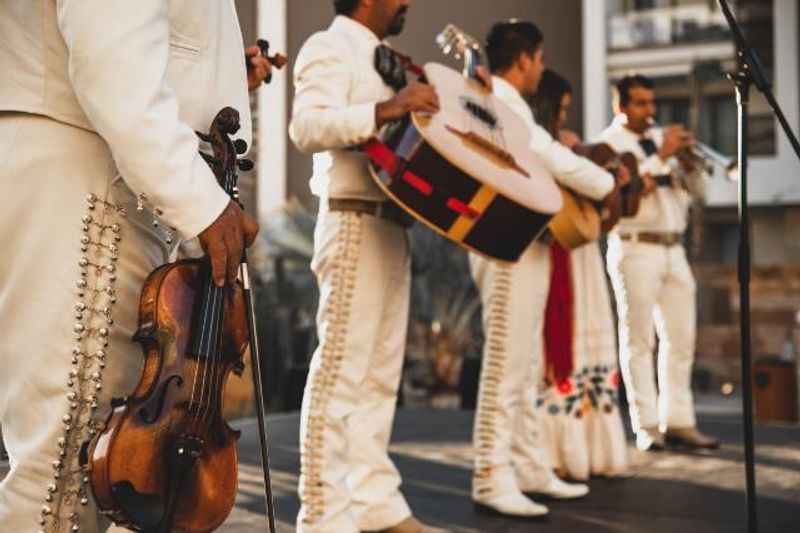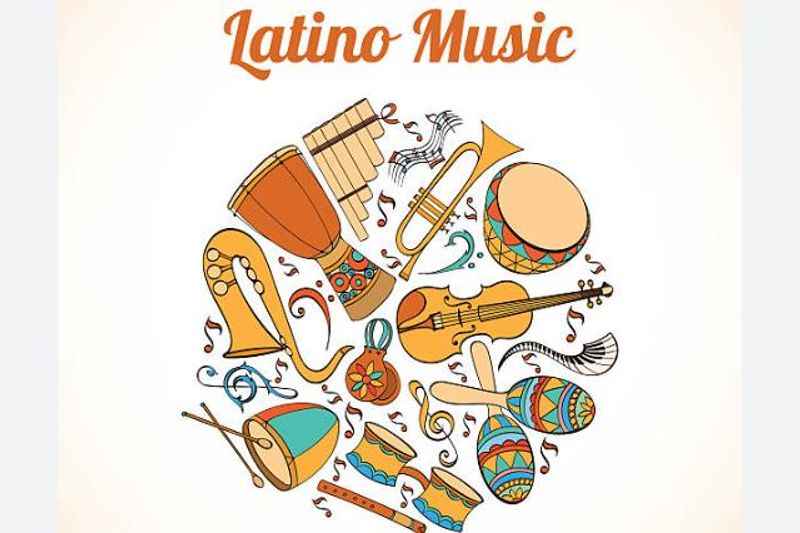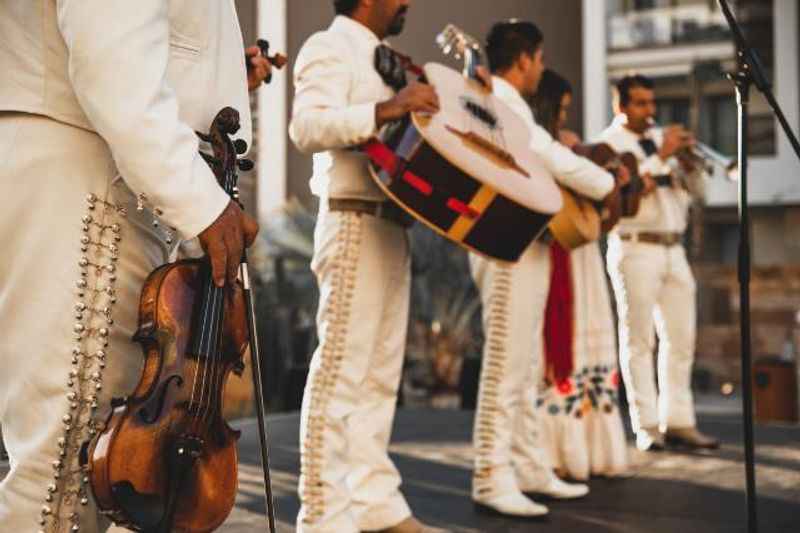14 Latin Music Genres & Musical Styles

Welcome to your simple guide to Spanish and Latin music. Today, we are going to run down some of the popular genres of this broad and varied musical style.
We'll look at musical expressions from across the Americas and Spain, discuss the themes they explore, and dive into their origins.
By the end of this guide, you'll be ready to take to the dance floor and celebrate the wonderful diversity of Spanish and Latin American music.
An Introduction to the Latin Music Genre(s)

Latin America generally refers to all the countries in North, Central, and South America that speak Spanish and Portuguese. Sometimes French Caribbean countries are also included in this definition.
Latin music is music originating in Spain and Latin America. This term encompasses a wide range of genres, styles, influences, and music. As you can imagine, there are endless subgenres and styles of Latin music. Today, we will explore some of the most prominent.
You'll hear a lot of brass instruments in Latin music, as well as various string instruments and African percussion instruments. Latin music is considered to be a kind of "world music" as it doesn't follow North American or British pop and folk traditions.
There is a huge African influence in Latin music as the African slaves brought their music with them to the new world and their rhythms changed Latin music forever. Salsa, Bachata, Merengue, Samba, and many more Latin music genres have been shaped by African beats.
Latin Music: A Breakdown

So, without further ado, let's dive into the various different types of Latin music
1. Salsa
Perhaps the most famous genre of Latin music is salsa. Traditional salsa music has its roots in Cuba and Puerto Rico. It is created with a three-drum section of bongos, congas, and timbales.
Salsa's distinctive feature is its complex, syncopated rhythms. This means that you highlight the spaces between the notes ("one-and-two-and-three-and-four").
Celia Cruz is hailed as the Queen of Salsa music, and other notable artists include Marc Anthony and Rubén Blades. Salsa incorporates a variety of musical styles including rock, jazz, and other Latin American musical traditions.
Modern salsa was born in New York City in the late 1960s and early 1970s and to this day it is constantly evolving.
2. Bachata
Originating in the poorer areas of the Dominican Republic in the 1900s, Bachata music has Spanish influences and elements of African and Indigenous music. This style of music represents the diversity of the Dominican people.
A Bachata group is made up of five instruments: requinto (lead guitar), Segunda (rhythm guitar), bass guitar, bongos, and a metal scraper known as a güira. The songs are often romantic and deal with themes of sadness and heartbreak.
3. Merengue
Merengue music also originated in the Dominican Republic, but is popular across Central America. This style of music gained popularity in the mid-1800s and is defined by its slow tempo and sentimental melodies.
Traditionally, Merengue music was played with European string instruments, but these were replaced by the diatonic accordion, a two-sided drum also known as a Tambora, and the güira.
The accordion represents the European influences in the Dominican Republic, while the Tambora represents the African influences and the güira represents the Indigenous people. This is the synthesis of the three cultures that make up the Dominican Republic.
4. Samba
Samba is a Brazilian music genre that has its roots in the Afro-Brazilian communities of Rio de Janeiro in the late 1900s. This genre of Latin music is played predominantly on percussion instruments and accompanied by strings.
Carmen Miranda and Cartola are two iconic Brazilian artists who are famous for shaping the Samba genre of music.
5. Tango
Established in Argentina in the late 1800s, the Tango was born from the diverse population of migrants arriving in Argentina at the time. Its influences include polkas, European minuet dances, and African rhythms.
Tango music was first played in dance halls and brothels in Buenos Aires and Montevideo. The songs deal with themes of sadness and loss. Juan D'Arienzo and Carlos Gardel are well-known Tango musicians.
The Tango can be played by one solo guitar, a guitar duo, or an ensemble. The ensemble typically has at least two violins, a flute, a piano, a double bass, and at least two bandoneóns, which are from the concertina family of instruments.
6. Rumba
While Rumba now refers to a variety of musical styles, the word was first used in Cuba to refer to party music. Cuban Rumba is based on African music and dance traditions.
Percussion, vocal improvisation, and elaborate dancing are all characteristics of this Cuban music, which has a medium to fast tempo.
Ruma ensembles tend to have two or three conga drums and sticks. Notable Rumba groups include Los Papines and Los Muñequitos de Matanzas.
7. Mariachi
Mariachi music dates back to the 1800s and evolved in the countryside of western Mexico. A Mariachi ensemble includes as many as eight violins, two trumpets, at least one guitar, and stringed instruments like the vihuela and deep-bodied guitarrón.
All members take turns singing lead and backing vocals. The lyrics of Mariachi music tend to be passionate and express a strong sense of national identity and pride.
This genre of Mexican music is joyful and uplifting and is often played at birthdays, baptisms, and weddings.
8. Latin Jazz
The development of Jazz music had a huge impact on the creation of Mambo, Cuban popular music, and other Latin Jazz genres. Afro-Brazilian Jazz incorporates Samba and Bossa Nova. These subgenres of Latin Jazz have roots in Cuba, Brazil, and the USA.
Mambo originated in Cuba and was played by big bands. The Mambo dance craze took over the East Coast of the USA in the 1950s and incorporated elements of Jazz and Swing.
9. Reggaeton
This style of dance music originated in Panama with the building of the Panama Canal. African workers from the West Indies brought Afro-centric music such as Rumba, Mambo, Cha-Cha-Cha, and Reggae to Panama where these styles mixed with Hip-Hop to form Reggae en Español.
Over time, this musical genre began to dominate the Caribbean, particularly Puerto Rico, and in the 1980s it became Reggaeton. Jamaican dancehall is a huge influence on modern-day Reggaeton music.
Reggaeton has also given birth to a new genre of Latin music: Latin Trap. Bad Bunny's music falls under the Reggaeton and Trap genres. Some other popular Reggaeton artists include Daddy Yankee, Rosalía, and El General.
10. Latin Pop Music
Latin Pop is pop music in Spanish and Portuguese. It's a fusion of US-style popular music and Latin music genres from anywhere in Latin America and Spain.
This style of music encompasses a pretty broad spectrum of styles and crosses over into subgenres of Latin rock and dance music.
Ricky Martin is considered to be the King of Latin Pop music. Jennifer Lopez, Enrique Iglesias, and Gloria Estefan are also notable artists of this popular style.
11. Rock en Español
Spanish-language rock music had its beginnings in the 1950s in America. Gloria Ríos released 'El Relojito' in 1956 and this is considered the blueprint of the genre.
Another significant moment for Rock en Español was in 1958 when Ritchie Valens adapted the Mexican folk song ‘La Bamba' by fusing it with rock melodies.
The 1960s saw the nueva ola, or the new wave rock genre. Then, in the 1970s this genre came alive with famous artists Charly Garcia and Luis Alberto Spinetta.
12. Norteño
Also known as música norteña, this is a genre of regional Mexican music that developed in the late 1800s. It is an interesting mixture of Mexican music and Austrian-Czech folk music. Typical norteño instruments include the accordion and the bajo sexto, a 12-string guitar.
This genre often deals with themes of social issues, though there are also many norteño love songs. Los Tigres del Norte are a classic example of a norteño artist.
13. Tejano
Also finding roots in the 1800s, Tejano music originated in Texas primarily among the Mexican-American population. The music's foundation can be traced to the fusion of traditional Mexican folk music, German, Czech, and Polish polkas and waltzes, and other influences.
Initially, Tejano music relied on instruments like accordions, guitars, and acoustic drums. However, during the 1920s and 30s, it underwent an evolution, drawing influence from big band music. This led to the emergence of Tejano ensembles with swing bands playing Mexican folk music in a conjunto style.
As subsequent decades brought popular music trends like rock and roll, rhythm and blues, and pop to the forefront, Tejano music adapted accordingly. Notably, in the late 80s and early 90s, Selena emerged as a prominent and highly successful Tejano music star.
14. Flamenco
Flamenco music is a passionate and emotive art form deeply rooted in Spanish culture. Originating in the Andalusian region, it combines singing, guitar playing, dance, and rhythmic handclaps (palmas).
Flamenco's soulful melodies and intricate guitar rhythms convey a wide range of emotions, from profound sorrow to exuberant joy. The music often reflects themes of love, loss, and longing, expressing the struggles and triumphs of the human experience.
Flamenco's unique blend of Moorish, Jewish, and Gypsy influences contributes to its captivating allure, making it an important aspect of Spain's cultural identity and a cherished art form worldwide.
Rosalía is a Spanish singer and songwriter who incorporates elements of flamenco into her modern music. She is not strictly categorized as a traditional flamenco artist, but she has brought it back into the mainstream.
Why Learn About Latin American Music

Learning about the different types of Latin music is culturally enriching and important. Latin American music embodies a vibrant tapestry of diverse cultures, histories, and traditions, making it an essential gateway to understanding the region's people and their way of life.
Studying Latin American music fosters an appreciation for the immense artistic creativity and innovation present in the region.
From the infectious rhythms of salsa and samba to the soulful melodies of bolero and tango, each musical style carries unique stories and emotions, reflecting the experiences and aspirations of Latin American communities.
Moreover, Latin American music has deeply influenced global music trends, transcending borders and enriching various genres worldwide. Understanding its origins and evolution provides valuable insights into the interconnectedness of cultures on a global scale.
Furthermore, learning about Latin American music promotes cultural empathy and helps break down stereotypes, fostering a more inclusive and tolerant society.
By embracing the music, people also embrace the histories and struggles of Latin Americans, nurturing a greater sense of solidarity and understanding among diverse communities.
In essence, delving into Latin American music opens doors to a profound appreciation of cultural heritage, artistic expression, and the interconnectedness of humanity, making it an invaluable and enriching endeavor for individuals from all walks of life.
Learning About Spanish and Latin Musical Traditions for Travel

Learning about Spanish and Latin music can significantly enrich your travels by creating a deeper connection with the local culture and people. Understanding the rhythms, instruments, and lyrics of regional music helps you appreciate the essence of each destination and its unique traditions.
Attending live performances or participating in local dance events allows you to immerse yourself in authentic cultural experiences. Try booking tickets to a flamenco show in Spain, or a Meringue performance in the DR.
Music can also serve as a universal language, fostering communication and building bridges with locals. Whether you're strolling through the streets of Seville, dancing in a salsa club in Havana, or exploring the Andean highlands, embracing the music enhances the richness of your travel adventures.
Top 5 Travel Destinations for Musical Tourism in Latin America

Finally, if you want to book an exotic trip with a musical focus, here are our top 5 picks for culturally rich, musical, and colorful destinations in Latin American countries.
1. Havana, Cuba
Known for its rich musical heritage, Havana offers an authentic experience of Cuban music, including salsa, son, and rumba. You can visit local music clubs and bars to witness talented musicians and dancers in action. Everywhere you go in Havana, traditional music will follow.
2. Rio de Janeiro, Brazil
A vibrant city with diverse music and dance genres, Rio de Janeiro is famous for samba and bossa nova. Here, you can enjoy live performances at lively samba clubs and experience the music's infectious rhythms during the colorful Carnival celebrations.
3. Buenos Aires, Argentina
The birthplace of tango, Buenos Aires offers a captivating musical journey and insight into Latin American culture. You should explore tango salons, where passionate dancers and musicians bring this iconic national music to life.
4. Cartagena, Colombia
This coastal South American city boasts a lively music scene with a blend of traditional Colombian rhythms and Caribbean influences. Experience the vibrant beats of the local music and dance style known as cumbia, as well as other styles like vallenato in the streets and local venues.
5. Oaxaca City, Mexico
This vibrant city stands as a cultural hub where the soul of traditional Mexican music thrives. The city's vibrant music scene encompasses iconic genres like mariachi and banda.
Immersed in rich cultural heritage, Oaxaca City offers a delightful experience for music enthusiasts, allowing you to explore the enchanting sounds that have woven themselves into the tapestry of Mexican identity and celebrations.
What You Should Know Before You Travel to Latin America

Before traveling to Latin America, it's crucial to be well-prepared to ensure a safe and enjoyable journey. Research the specific countries you plan to visit to understand their entry requirements, cultures, customs, and local etiquette in various regions.
It's a good idea to learn some basic Spanish or Portuguese phrases, as language barriers may exist in certain regions. Moreover, stay updated on travel advisories and health recommendations, as well as any necessary or recommended vaccinations.
Be aware of potential safety concerns and take precautions while exploring unfamiliar areas, especially at night. Respect local traditions, be open-minded, and embrace the diverse cultures you encounter. Learn a bit about the indigenous people of the area, their languages, customs, and values.
Lastly, carry essential documents like passports, travel insurance, and emergency contact information for a smooth trip. If you prepare properly for your trip, you will have a magical and unforgettable time in this musical, culturally-rich part of the world.
FAQs About Spanish and Latin American Music
Now that we have explored a range of Spanish and Latin music genres, let's take a look at some frequently asked questions on this topic.
Is Latin Hip-hop the same as Reggaeton music?
No, Reggaeton and Hip-Hop are not the same. Reggaeton was strongly influenced by Hip-Hop and involves rap-like singing, but it also takes its rhythms and beats from Caribbean music.
Latin Hip-Hop music originated in the Bronx, New York in the 1970s.
What is the most popular genre of music in Latin America?
Latin America encompasses a huge portion of the world and it is hard to name one genre that is the most popular across all the Romance language-speaking countries.
However, Salsa is definitely one of the most popular of the traditional genres, while Reggaeton and Latin Pop are currently well-loved, among younger and middle-aged generations respectively.
What is a popular style of dance in Latin America?
Salsa, Bachata, Merengue, Samba, Tango, and Rumba are all Latin dance styles as well as genres of music.
Dancing to modern Latin music, like Reggaeton and pop music, incorporates elements of traditional Latin dances, but with a sexy, modern club feel.
Summing Up: Latin Music Genres & Musical Styles
As you can see, Latin music is a general term for a huge variety of musical genres across North, Central, and South America and Spain.
We've looked at several genres of Latin music, particularly Latin American music, the key instruments used, and where they originate.
By listening to Latin American music, you can learn a lot about the culture and diversity of countries like Puerto Rico and the Dominican Republic.
This can help prepare you for a trip to Latin America, where you can hear these genres played authentically and even learn how to dance to them.







